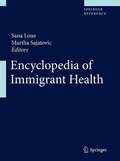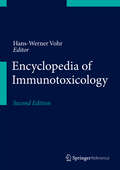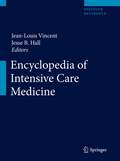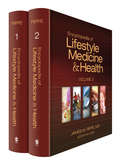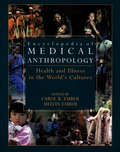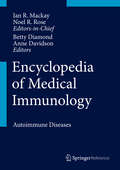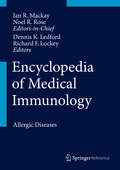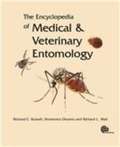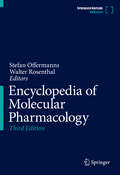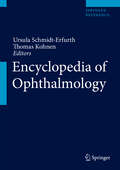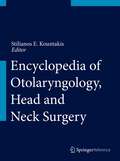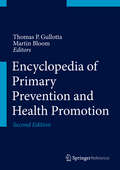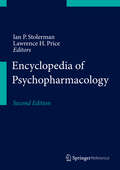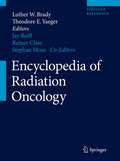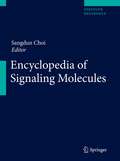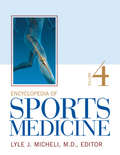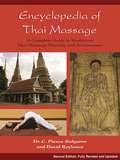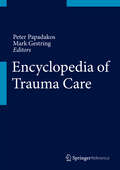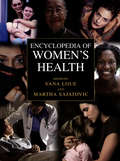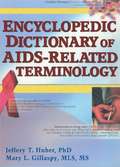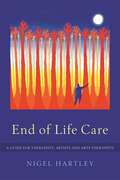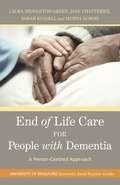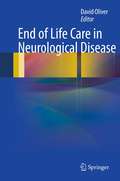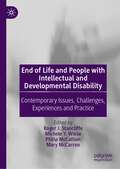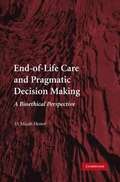- Table View
- List View
Encyclopedia of Immigrant Health
by Martha Sajatovic Sana LoueThere is increasing interest in the scientific literature on immigrant health and its impact on disease transmission, disease prevention, health promotion, well-being on an individual and population level, health policy, and the cost of managing all these issues on an individual, institutional, national, and global level. The need for accurate and up-to-date information is particularly acute due to the increasing numbers of immigrants and refugees worldwide as the result of natural disasters, political turmoil, the growing numbers of immigrants to magnet countries, and the increasing costs of associated health care that are being felt by governments around the world. Format and Scope: The first portion of the encyclopedia contains chapters that are approximately 25 to 40 manuscript pages in length. Each overview chapter includes a list of references and suggested readings for cross referencing within the encyclopedia. The opening chapters are: Immigration in the Global Context, Immigration Processes and Health in the U.S.: A Brief History, Alternative and Complementary Medicine, Culture-Specific Diagnoses, Health Determinants, Occupational and Environmental Health, Methodological Issues in Immigrant Health Research, Ethical Issues in Research with Immigrants and Refugees, Ethical Issues in the Clinical Context. The second portion of the book consists of alphabetical entries that relate to the health of immigrants. Entries are interdisciplinary and are drawn from the following fields of study: anthropology, demographics, history, law, linguistics, medicine, population studies, psychology, religion, and sociology. Each entry is followed by a listing of suggested readings and suggested resources, and also links to related terms within the whole book. Outstanding Features The book adopts a biopsychosocial-historical approach to the topics covered in the chapters and the entries. Each entry includes suggested readings and suggested resources. The chapters and entries are written graduate level that is accessible to all academics, researchers, and professionals from diverse backgrounds. We consider the audience for the entries to be well educated, but a non expert in this area. The primary focus of the book is on the immigrant populations in and immigration to magnet countries. References are made to worldwide trends and issues arising globally. In addition to the comprehensive subject coverage the text also offers diverse perspectives. The editors themselves reflect the multidisciplinary nature of the topics, with expertise in psychiatry, law, epidemiology, anthropology, and social work. Authors similarly reflect diverse disciplines.
Encyclopedia of Immunotoxicology
by Hans-Werner VohrThis work provides rapid access to focused information on topics of Immunotoxicology not only for scientists and those dealing with laboratory aspects but also for lecturers and advanced students. Over 200 contributing authors - including many of the world's top specialists - have contributed full essays on all relevant topics, supplemented by keyword definitions of related terms. Full essays are structured uniformly to provide reader-friendly information on all aspects of Immunotoxicology, including methods of testing and analysis, characteristics of substances, the regulatory environment and the relevance of these to humans.
Encyclopedia of Intensive Care Medicine
by Jesse B. Hall Jean-Louis VincentThe aim of this comprehensive encyclopedia is to provide detailed information on intensive care medicine contributing to the broad field of emergency medicine. The wide range of entries in the Encyclopedia of Intensive Care Medicine are written by leading experts in the field. They will provide basic and clinical scientists in academia, practice, as well as industry with valuable information about the field of intensive care medicine, but also people in related fields, students and teachers will benefit from the important and relevant information on the most recent developments in emergency medicine. The Encyclopedia will contain 4 volumes, and published simultaneously online. The entire field has been divided into 14 sections. All entries will be arranged in alphabetical order with extensive cross-referencing between them.
Encyclopedia of Lifestyle Medicine and Health
by James M. RippeRequest a FREE 30-day online trial to this title at www.sagepub.com/freetrialThe Encyclopedia of Lifestyle Medicine and Health offers thorough coverage of relevant topics and issues in historical and contemporary context, with information on lifestyle habits and practices and their impact on health. These volumes sort out the science behind nightly news reports and magazine cover stories, helping the reader to discern sound, evidence-based advice from that which is merely fad. The volumes convey the latest research on lifestyle medicine, incorporating content from such areas as health psychology, communication, public policy and health promotion, and disease prevention, among others. Readers are empowered to lead and promote healthier lifestyles after perusing the hundreds of signed, authoritative entries written by leading experts in their respective fields. Accompanying bibliographies and suggested readings provide guidance toward more in-depth resources. This comprehensive reference resource is written accessibly, making it useful for a broad audience, including students and academics in the fields of health, physical education, biology, medicine, nursing and allied health, physical therapy, nutrition, public health, and health communication, as well as for lay readers interested in learning how to lead a healthier lifestyle.
Encyclopedia of Medical Anthropology
by Carol R. Ember Melvin EmberMedical practitioners and the ordinary citizen are becoming more aware that we need to understand cultural variation in medical belief and practice. The more we know how health and disease are managed in different cultures, the more we can recognize what is "culture bound" in our own medical belief and practice. The Encyclopedia of Medical Anthropology is unique because it is the first reference work to describe the cultural practices relevant to health in the world's cultures and to provide an overview of important topics in medical anthropology. No other single reference work comes close to marching the depth and breadth of information on the varying cultural background of health and illness around the world. More than 100 experts - anthropologists and other social scientists - have contributed their firsthand experience of medical cultures from around the world.
Encyclopedia of Medical Immunology
by Anne Davidson Ian R. Mackay Noel R. Rose Betty DiamondDifferent from other resources, this volume offers a broad appeal to microbiologists, immunologists, and infectious disease specialists on Autoimmune Diseases. The volume covers topics such as skin and alopecia, Kidney, Liver, Paraneoplastic, Resolution of inflammation, Cardiovascular/systemic inflammation and atherosclerosis, Gut, Regulatory lymphocytes T, B, other and Rheumatic Disease. The volume is written by internationally renowned authors who are authorities in their respective fields.
Encyclopedia of Medical Immunology
by Ian R. Mackay Noel R. Rose Dennis K. Ledford Richard F. LockeyVolume Allergic Diseases is a comprehensive, multi-authored reference work, offering a broad appeal to microbiologists, immunologists, and infectious disease specialists. The volume explores all aspects of allergic diseases, body systems and vaccines. Emphasis is placed on genetics, physiology, metabolism, pathogenesis, and applied microbiology. Under the leadership of some of the most world renowned names in the field, the encyclopedia brings together an outstanding collection of contributions by top scientists in a variety of fields. The entries are listed alphabetically and provide full references. The volume covers the following topics: Food Allergy and gastrointestinal Allergic Diseases Insect Allergy Allergy Diagnosis and Testing Allergy Treatment: Pharmacotherapy Asthma and Other Allergic Lower Respiratory Disease Biology of IgE, Mast Cells and Eosinophils Specific Allergens Causing Human Disease Atopic Dermatitis, Urticaria and Dermatologic Allergy Allergy Treatment: Immunotherapy, Immunomodulator Therapy and Allergen Avoidance"
Encyclopedia of Medical and Veterinary Entomology
by Richard Russell Richard Wall Domenico OtrantoArthropod transmitted infections continue to be a front-line issue in all regions of the world. Understanding the insects that transmit diseases, the mechanisms of infection and the resulting diseases is vital to doctors, veterinarians, public health workers and disease control agencies. This major reference examines the biology, classification and control of arthropods that cause disease in animals and humans. The morphology, taxonomy and phylogeny of fleas, flies, lice, mites, midges, mosquitoes and ticks are described, with descriptions of their medical and veterinary significance, diseases they cause, insect distribution and global disease spread. Updated, developed and reworked from Doug Kettle's seminal Medical and Veterinary Entomology, this major new reference presents vital information in encyclopedia format, with alphabetical entries and an extensive index to make key facts easy to find. This new treatment of the subject provides accessible content and up-to-date research, illustrated by line drawings and colour photographs.
Encyclopedia of Molecular Pharmacology
by Stefan Offermanns Walter RosenthalAn essential text, this is a fully updated second edition of a classic, now in two volumes. It provides rapid access to information on molecular pharmacology for research scientists, clinicians and advanced students. With the A-Z format of over 2,000 entries, around 350 authors provide a complete reference to the area of molecular pharmacology. The book combines the knowledge of classic pharmacology with the more recent approach of the precise analysis of the molecular mechanisms by which drugs exert their effects. Short keyword entries define common acronyms, terms and phrases. In addition, detailed essays provide in-depth information on drugs, cellular processes, molecular targets, techniques, molecular mechanisms, and general principles.
Encyclopedia of Ophthalmology
by Ursula Schmidt-Erfurth Thomas KohnenRapid advances in pathogenetic insight, diagnostic and therapeutic modalities, and basic research continuously influence the state of the art in ophthalmology. This comprehensive encyclopedia offers a systematic and complete source of information including basic principles and novel updates, both clinical and scientific. The encyclopaedic format offers comprehensive access to focused information on all relevant topics in a clear and user-friendly manner. The spectrum ranges from short definitions, cross references, acronyms to disease chapters including epidemiology, symptoms and differential diagnosis, sections on diagnostic and therapeutic technologies, and comprehensive scientific summaries describing recent findings as well as results from relevant studies. The material is presented in a standardized, uniform and concise way throughout all clinical and academic sections. High-quality images highlight visual information and tables and graphs summarize important data. The encyclopaedia is available in book and electronic format which is linked to relevant ophthalmologic journals and is continuously updated. All chapters are authored by leading experts in the specific field. The target audiences are clinicians in ophthalmology and related specialties, researchers, and students.
Encyclopedia of Otolaryngology, Head and Neck Surgery
by Stilianos E. KountakisOtolaryngology Head and Neck Surgery is the medical and surgical specialty addressing disorders of the head and neck in both adult and pediatric populations. The goal of the encyclopedia is to serve as a single and comprehensive source of all the information that is essential for students and practitioners of the specialty. The vast amount of information included in the encyclopedia is divided into 5 volumes in line with the subspecialties of general otolaryngology, head and neck surgery, pediatric otolaryngology, otology-neurotology, and facial plastics. All volume editors are internationally recognized otolaryngologists with experience in publishing. Each section editor recruited experienced authors from all over the world to contribute on structured topics, and all entries are supported by published references. Thus, all information included in the encyclopedia is from credible sources and has been carefully screened for accuracy. The strength of the encyclopedia is its online availability and quick search features, which allow rapid retrieval of definitions and more in-depth information. Key words are hyperlinked to provide a gateway to numerous referenced manuscripts, journals, and books.
Encyclopedia of Primary Prevention and Health Promotion
by Thomas P. Gullotta Martin BloomEncyclopedia of Primary Prevention and Health Promotion
Encyclopedia of Psychopharmacology
by Ian P. Stolerman Lawrence H. PricePsychopharmacology is the study of the effects of psychoactive drugs on the functioning of the central nervous system at all levels of analysis, thus embracing cognition, behavior, psychological states, neurophysiology, neurochemistry, gene expression, and molecular biology. It includes, as an integral part of its domain, the interaction of environmental and genetic factors with psychoactive drug action, the medicinal and social uses of drugs, and the misuse and abuse of psychoactive substances. The aim of this comprehensive encyclopedia is to provide detailed information on psychopharmacology and its sub-disciplines, such as clinical psychopharmacology, molecular neuropsychopharmacology, behavioral pharmacology in laboratory animals, preclinical psychopharmacology, and human experimental psychopharmacology. The wide-ranging entries in the Encyclopedia of Psychopharmacology are written by leading experts drawn from a broad diversity of backgrounds and areas of specialization. The entries, comprehensive but succinct, provide basic and clinical scientists in academia, as well as industry, with the most important and relevant information on recent developments in psychopharmacology and its closely allied disciplines. The essential information about the field contained in these entries is readily accessible to clinicians, scholars, students, teachers, and interested laypeople.
Encyclopedia of Radiation Oncology
by Luther W. Brady Jay E. Reiff Reiner Class Stephan Mose Theodore YaegerThe aim of this comprehensive encyclopedia is to provide detailed information on radiation oncology. The wide range of entries are written by leading experts. They will provide basic and clinical scientists in academia, practice and industry with valuable information about the field of radiation oncology. Those in related fields, students, teachers, and interested laypeople will also benefit from the important and relevant information on the most recent developments.
Encyclopedia of Signaling Molecules
by Sangdun ChoiBiological processes are driven by complex systems of functionally interacting signaling molecules. Thus, understanding signaling molecules is essential to explain normal or pathological biological phenomena. A large body of clinical and experimental data has been accumulated over these years, albeit in fragmented state. Hence, systems biological approaches concomitant with the understanding of each molecule are ideal to delineate signaling networks/pathways involved in the biologically important processes. The control of these signaling pathways will enrich our healthier life. Currently, there are more than 30,000 genes in human genome. However, not all the proteins encoded by these genes work equally in order to maintain homeostasis. Understanding the important signaling molecules as completely as possible will significantly improve our research-based teaching and scientific capabilities. This encyclopedia presents 350 biologically important signaling molecules and the content is built on the core concepts of their functions along with early findings written by some of the world's foremost experts. The molecules are described by recognized leaders in each molecule. The interactions of these single molecules in signal transduction networks will also be explored. This encyclopedia marks a new era in overview of current cellular signaling molecules for the specialist and the interested non-specialist alike During past years, there were multiple databases to gather this information briefly and very partially. Amidst the excitement of these findings, one of the great scientific tasks of the coming century is to bring all the useful information into a place. Such an approach is arduous but at the end will infuse the lacunas and considerably be a streamline in the understanding of vibrant signaling networks. Based on this easy-approach, we can build up more complicated biological systems.
Encyclopedia of Sports Medicine
by Dr Lyle J. MicheliTo request a free 30-day online trial to this product, visit www.sagepub.com/freetrialWith an ever-growing variety of sports and exercise opportunities open to people of all ages, classes, and races, participation in casual sports has blossomed in recent decades, while interest in collegiate and professional sports has continued to soar. The field of sports medicine is thriving in response to the demand for health care professionals to care for people involved in vigorous exercise. Now more than ever, it is imperative that doctors, physical therapists, surgeons, nurses, and alternative medicine practitioners understand and are able to treat effectively the types of conditions stemming from all types of physical activity, ranging from pleasure walking to professional football. Presenting state-of-the-art research and evidence-based applications, this four-volume resource provides the most comprehensive and accessible information available on sports medicine. The Encyclopedia of Sports Medicine describes all aspects of the field with perspectives, concepts, and methods from the medical, behavioral, and social sciences and physical education.Key Features· Includes contributions from preeminent healthcare professionals who are renowned experts · Presents a broad spectrum of entries covering a variety of key topics, a glossary, and two appendices· Contains more than 550 tables and images, including anatomical drawings, X-rays, and MRI scans· Illustrates selected diagnostic and treatment techniques step-by-step with more than 200 photographs· Offers an in-depth examination of the various career opportunities in this area, including orthopedists, athletic trainers, sports psychologists, and nutritionistsKey Themes· Conditioning and Training· Diagnosis and Treatment of Sports Injuries· Diet and Nutrition· Doping and Performance Enhancement· Exercise Physiology, Biomechanics, Kinesiology· Injuries and Disorders· Injury Prevention· Medical Conditions Affecting Sports Participation· Rehabilitation and Physical Therapy· Special Populations· Specialties and Occupations in Sports Medicine· Sports and Society· Sports and Sports Medicine· Sports Psychology· Sports-Specific Injuries· Women and Sports
Encyclopedia of Thai Massage
by David Roylance C. Pierce SalgueroDrawing from Thai history, cultural studies, Buddhist religion, and yogic practices, as well as a modern understanding of anatomy and physiology, this guidebook bridges the gap between theory and practice while presenting bodywork as it is understood in Thailand-as a therapeutic medical science. Presenting detailed analysis of each step in a Thai massage routine, the history, spiritual traditions, and ethical codes are offered in an engaging, informal style. Numerous photographs and diagrams illustrate the variety of techniques used, and examples of routines for treating specific disorders are discussed. Updated with new layout, photos, and expanded text, this exhaustive handbook is complete with a section on the main energy meridians and diagrams of acupressure points, making it the perfect tool to accompany anyone studying this popular healing modality.
Encyclopedia of Trauma Care
by Peter J. Papadakos Mark L. GestringThis encyclopedia features practical information on major topics in trauma management. It covers the full range of organ-specific injuries as well as other important issues, including critical care, complications, and ethical issues.
Encyclopedia of Women's Health
by Martha Sajatovic Sana LoueDesignated a Reference Reviews Top Ten Print Reference Source 2005 The Encyclopedia of Women's Health meets this challenge by bringing together an impressive array of experts on topics from reproductive issues to gastrointestinal illnesses. This skilfully edited volume, informed by current health issues and health-care realities, offers readers practical information, historical aspects, and future directions, all meticulously researched and conveniently presented. Key features include: -Accessible A-to-Z coverage, including AIDS, birth control, hormone replacement therapy, teen pregnancy, sexual harassment, violence, body image, access to health care and more. -Entries spanning the medical, psychological, sociocultural, spiritual, and legal arenas. -Medical topics explored from both conventional and complementary perspectives. -Cross-cultural data illustrate issues as they apply to minority women, rural women, the elderly, and other underserved populations. -Special chapters on disparities in women's health and health care. -Historical overview of women in health - as patients and as professionals. -Suggested readings and resource lists.
Encyclopedic Dictionary of AIDS-Related Terminology
by Jeffrey T Huber Mary L GillaspyMake sense out of confusing HIV/AIDS terminology!Finally, here is a reference work that contains clear and useful definitions of words, phrases, and medical terms associated with HIV/AIDS! The Encyclopedic Dictionary of AIDS-Related Terminology is an easy-to-understand guide to all of the mainstream jargon surrounding this epidemic. This user-friendly volume brings you a number of essential features, such as: popular and scientific names of conditions and medicines listings of addresses and contact information for organizations and government agencies that are concerned with HIV/AIDS definitions of historical terms, abbreviations, and acronyms related to HIV/AIDS details of corporate and organizational involvement with HIV/AIDS research, prevention, and interventionThe Encyclopedic Dictionary of AIDS-Related Terminology also includes entries that describe and relate to legal, social, psychological, and religious issues, not just medical terms, to give readers a complete source that will meet all of their needs. With this single resource, you will be able to easily and thoroughly understand the sometimes complex jargon associated with HIV/AIDS. For librarians, AIDS service organizations, people living with AIDS, and the general public, the Encyclopedic Dictionary of AIDS-Related Terminology is a comprehensive guide to conditions and medical terms associated with HIV/AIDS. Dates, histories, addresses, telephone numbers, and Web site addresses are included with many entries.Including words specific to the epidemic as well as related psychosocial phrases, this essential volume offers you definitions of HIV/AIDS medications and listings of organizations and government agencies that are concerned with the disease.
End of Life Care for People with Dementia: A Person-Centred Approach
by Murna Downs Sarah Russell Jane Chatterjee Laura Middleton-GreenPeople with dementia need increasingly specialised support as they approach the end of life, and so too do their families and the professionals working with them. This book describes not only what can be done to ensure maximum quality of life for those in the final stages of the illness, but also how best to support those involved in caring for them. Emphasising the importance of being attuned to the experiences and needs of the person with dementia, the authors explain why and how they should be included in decisions relating to their end of life care. Practical strategies for ensuring physical and emotional wellbeing are provided, drawing on useful examples from practice and providing solutions to potential challenges that carers and family members will face. Dilemmas surrounding end of life care are explored in detail, including the moral dilemma of medical intervention, and the authors suggest ways of supporting family members through the process in terms of providing information, helping them adjust to change and loss, and involving them in their relative's care, and at how care staff can be supported through appropriate education and training, team building and information-giving. This is an essential resource for anyone who wishes to provide compassionate, person-centred care for a person with dementia as they approach the end of life, including care staff, nurses, social workers and related professionals.
End of Life Care in Neurological Disease
by David OliverAs end of life care is extended to more and more people it is increasingly important that people with progressive neurological disease are recognised as having particular issues as their disease progresses. This group of people with advancing motor neurone disease, multiple sclerosis, Parkinson's disease, multiple systems atrophy, progressive supranuclear palsy, Huntington's disease and other progressive neurological disease face increasing problems - with physical symptoms and psychosocial and spiritual issues for both themselves and their families and carers. This book encourages health and social care professionals to become closely involved in the care of these people and their families, so that advance care plans can be started and quality of life maintained. This book addresses the principles and practice of developing end of life care strategies for neurological disease, written with a clinical, multidisciplinary focus and illustrated with detailed case studies.
End of Life and People with Intellectual and Developmental Disability: Contemporary Issues, Challenges, Experiences and Practice
by Philip McCallion Roger J. Stancliffe Michele Y. Wiese Mary McCarronThis book on end of life examines how to include people with intellectual and developmental disability in the inevitability of dying and death. Comprising 17 chapters, it addresses challenging and under-researched topics including suicide, do-not-resuscitate, advance care planning, death doulas and accessible funerals. Topics reflect everyday community, palliative care, hospice and disability services.The book proposes that the rights of people with disabilities should be supported up to and after their death. Going beyond problem identification, the chapters offer positive, evidence-supported responses that translate research to practice, together with practice examples and resources grounded in lived experience. The book is applicable to readers from the disability field, and mainstream health professionals who assist people with disability in emergency care, palliative care or end-of-life planning
End-of-Life Care and Pragmatic Decision Making
by D. Micah HesterEvery one of us will die, and the processes we go through will be our own - unique to our own experiences and life stories. End-of-Life Care and Pragmatic Decision Making provides a pragmatic philosophical framework based on a radically empirical attitude toward life and death. D. Micah Hester takes seriously the complexities of experiences and argues that when making end-of-life decisions, healthcare providers ought to pay close attention to the narratives of patients and the communities they inhabit so that their dying processes embody their life stories. He discusses three types of end-of-life patient populations - adults with decision-making capacity, adults without capacity, and children (with a strong focus on infants) - to show the implications of pragmatic empiricism and the scope of decision making at the end of life for different types of patients.
